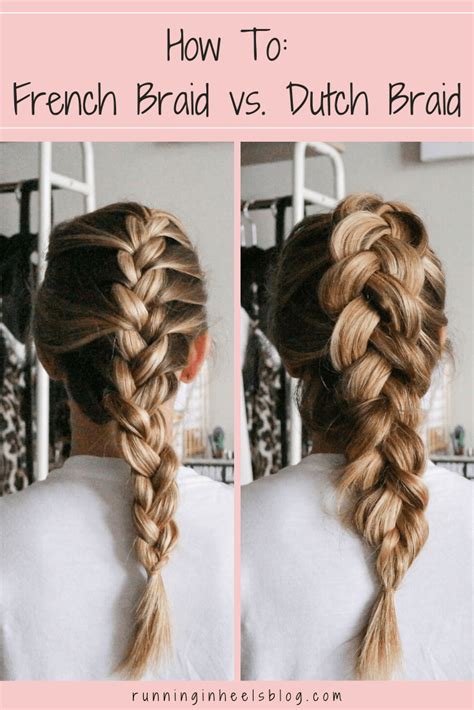Introduction

Braiding is an ancient hair styling technique that has been passed down through generations. Two of the most popular braiding methods are the Dutch braid and the French braid. Both styles create intricate and elegant looks, but they differ in their techniques, appearance, and applications. This comprehensive article delves into the intricacies of each method, providing a thorough comparison to help you choose the perfect braid for your hair and style.
Dutch Braid
Technique:
- The Dutch braid, also known as a reverse French braid, starts by dividing the hair into three equal strands.
- The left strand is crossed over the middle strand, then the right strand is crossed over the middle strand.
- The process continues with the left strand being crossed under the middle strand, and the right strand being crossed under the middle strand.
- As each strand is crossed, a small section of hair from the side is added to it, creating the Dutch braid’s characteristic “underneath” effect.
Appearance:
- Dutch braids are thicker and wider than French braids due to the added hair from the sides.
- They display a raised, three-dimensional effect, making them visually striking.
- The Dutch braid’s texture is fuller and more textured, offering a more voluminous look.
Applications:
- Dutch braids are versatile and can be styled for various occasions, including parties, weddings, and everyday wear.
- They are particularly suitable for creating intricate hairstyles, such as buns, ponytails, and crowns.
- Dutch braids can also be used to add volume and texture to fine or thin hair.
French Braid
Technique:
- The French braid, also known as a classic braid, begins with the hair divided into three equal strands.
- The right strand is crossed over the middle strand, then the left strand is crossed over the middle strand.
- Unlike the Dutch braid, hair is added to the strands from the top of the head, rather than from the sides.
- The process continues with the left strand being crossed over the middle strand, the right strand being crossed over the middle strand, and hair being added from the top.
Appearance:
- French braids are flatter and narrower than Dutch braids due to the absence of hair added from the sides.
- They have a more intricate and delicate appearance, with a tighter weave and less volume.
- The French braid’s texture is smooth and sleek, resulting in a polished and elegant look.
Applications:
- French braids are ideal for creating a timeless and sophisticated style.
- They are commonly used for formal events, such as weddings, proms, and graduations.
- French braids can also be incorporated into everyday hairstyles, adding a touch of elegance and femininity.
Comparison Table
| Feature | Dutch Braid | French Braid |
|---|---|---|
| Technique | Hair added from the sides, under the middle strand | Hair added from the top of the head, over the middle strand |
| Appearance | Thick, wide, three-dimensional | Flat, narrow, intricate |
| Texture | Full, textured | Smooth, sleek |
| Volume | More voluminous | Less voluminous |
| Applications | Intricate hairstyles, everyday wear | Formal events, everyday wear |
Pros and Cons
Dutch Braid:
Pros:
- Creates a visually striking and voluminous look.
- Versatile and suitable for various hairstyles.
- Adds texture and volume to thin or fine hair.
Cons:
- More time-consuming to braid.
- Can be bulky and heavy for some hair types.
French Braid:
Pros:
- Classic and elegant style.
- Easy to braid, even for beginners.
- Creates a more polished and refined look.
Cons:
- Less voluminous than the Dutch braid.
- May not be suitable for thick or coarse hair.
Tips and Tricks
For Dutch Braids:
- Use hairspray or mousse to provide extra hold.
- Add hair from the sides evenly to create a consistent thickness and texture.
- Practice regularly to improve your technique and speed.
For French Braids:
- Start with slightly damp hair to prevent tangles and ensure a smooth braiding process.
- Keep the strands tightly crossed to create a secure and intricate braid.
- Use a hair clip at the end to secure the braid and prevent unraveling.
Step-by-Step Approach
Dutch Braid:
- Divide your hair into three equal strands.
- Cross the left strand under the middle strand.
- Cross the right strand under the middle strand.
- Add a small section of hair from the left side to the left strand.
- Cross the left strand (with added hair) under the middle strand.
- Repeat steps 4-5 for the right side.
- Continue the process, alternating between adding hair from the sides and crossing the strands.
French Braid:
- Divide your hair into three equal strands.
- Cross the right strand over the middle strand.
- Cross the left strand over the right strand.
- Add a small section of hair from the top of your head to the left strand.
- Cross the left strand (with added hair) over the middle strand.
- Repeat steps 4-5 for the right side.
- Continue the process, alternating between adding hair from the top and crossing the strands.
Creative New Word Application
The term “braideology” can be coined to refer to the study and practice of braiding. This term encompasses the various techniques, styles, and applications of braiding, offering a comprehensive understanding of this ancient hair styling art.
Conclusion
Dutch braids and French braids are both beautiful and versatile braiding styles that offer unique advantages and applications. The Dutch braid creates a bold and voluminous look, while the French braid provides a classic and elegant style. Ultimately, the best choice between the two depends on your personal preferences, hair type, and the occasion for which you are styling your hair. With practice and patience, you can master both techniques and elevate your hair styling game.
